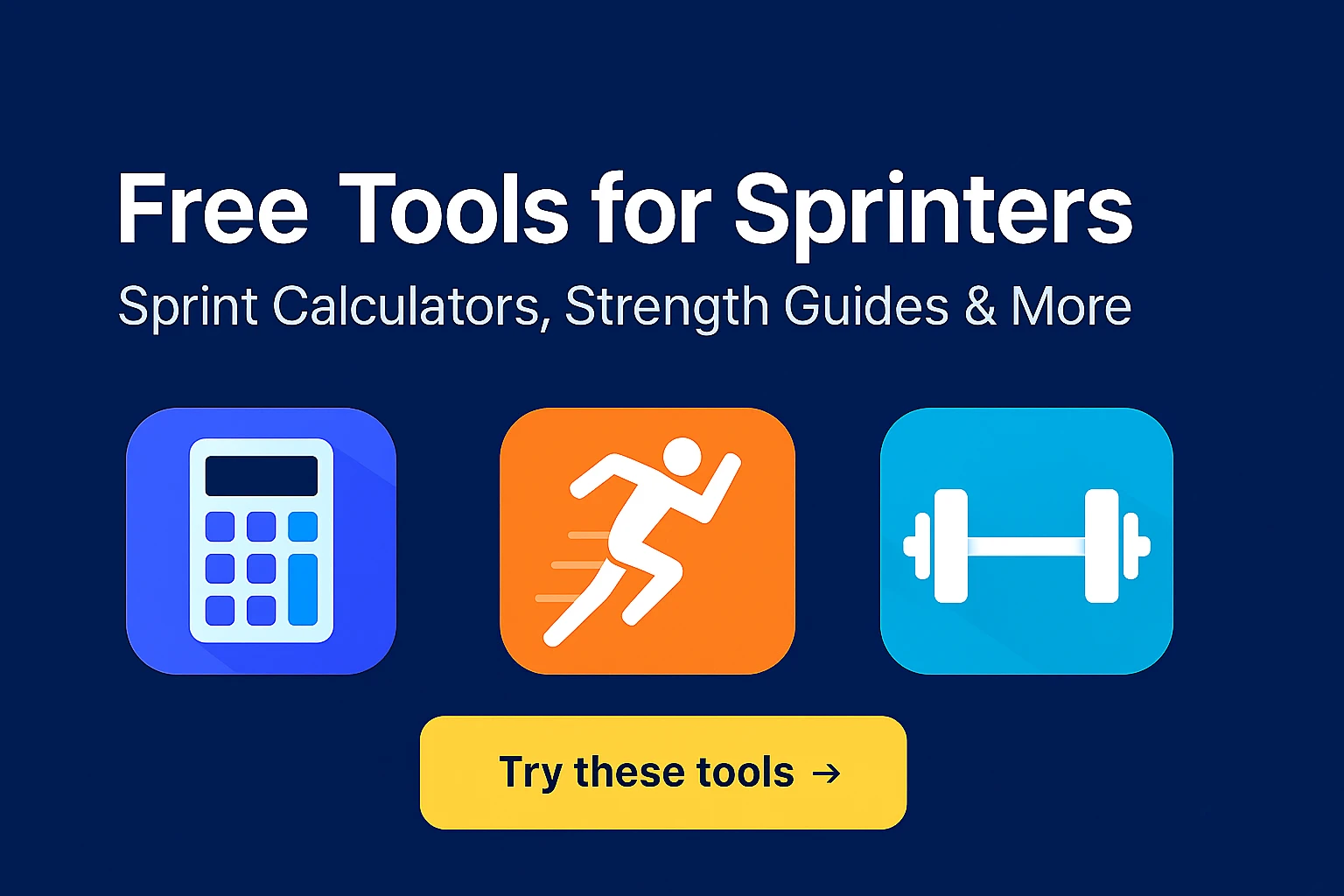Training Volume Analysis: The Key to Athletic Performance Optimization
In the world of sports performance, understanding and analyzing training volume data has become the cornerstone of effective athletic development. Whether you're a sprinter, strength athlete, or mul...
In the world of sports performance, understanding and analyzing training volume data has become the cornerstone of effective athletic development. Whether you're a sprinter, strength athlete, or multi-sport competitor, mastering volume interpretation can be the difference between plateauing and achieving breakthrough performance gains. This comprehensive guide builds upon our foundational knowledge from Sprint Training 101 and explores how advanced volume analysis can revolutionize your training approach.
What Is Training Volume Analysis?
Training volume analysis is the systematic evaluation of the total work performed during training sessions, including sets, reps, weight, distance, duration, and intensity. This data-driven approach provides athletes and coaches with actionable insights to optimize training programs and prevent overtraining or undertraining.
The Science Behind Volume Analysis
Modern sports science recognizes that training volume is one of the primary drivers of athletic adaptation. The relationship between volume, intensity, and recovery creates the foundation for progressive overload and performance improvement.
Key Components of Training Volume:
- Volume Load: Total weight × reps × sets
- Distance Volume: Total meters/yards covered
- Time Volume: Duration of training sessions
- Intensity Volume: Percentage of maximum effort
- Frequency Volume: Number of training sessions per week
Why Training Volume Analysis Matters in Sports Performance
1. Precision in Training Programming
Traditional training often relies on guesswork and general guidelines. Volume analysis provides specific, measurable data that allows for precise adjustments to training programs.
2. Overtraining Prevention
By tracking volume trends, athletes can identify patterns that lead to overtraining before it becomes a problem. Early detection of volume spikes helps maintain optimal performance levels.
3. Performance Optimization
Volume analysis reveals the optimal training load for each athlete, maximizing performance gains while minimizing injury risk and recovery time.
4. Individualized Training Plans
Every athlete responds differently to training stimuli. Volume analysis helps create personalized training programs based on individual response patterns.
Volume Interpretation Across Different Sports
Strength Training Volume Analysis
In strength sports, volume is typically calculated as:
Volume Load = Weight × Reps × Sets
Example: 3 sets of 10 reps at 100kg = 3,000kg total volume load
Key Metrics to Track:
- Weekly volume load progression
- Volume-to-intensity ratios
- Exercise-specific volume distribution
- Recovery patterns between sessions
Sprint Training Volume Analysis
For sprint athletes, volume includes:
- Total distance covered
- Number of sprints performed
- Rest intervals between sprints
- Intensity levels (percentage of max speed)
Volume Calculation Example:
- 8 × 60m sprints at 90% intensity
- Total volume: 480m at high intensity
- Rest intervals: 3 minutes between sprints
For more detailed sprint training techniques, check out our Sprint Training 101 guide and Essential Sprint Drills for improving your form and performance.
Endurance Training Volume Analysis
Endurance athletes focus on:
- Weekly mileage/distance
- Training time
- Intensity distribution (easy/moderate/hard)
- Heart rate zones and duration
Advanced Volume Analysis Techniques
Acute-to-Chronic Workload Ratio (ACWR)
This advanced metric compares recent training load (acute) to average training load over 4 weeks (chronic):
ACWR = Acute Load (7 days) ÷ Chronic Load (28 days)
Optimal Ratios:
- 0.8-1.3: Sweet spot for performance
-
1.5: Increased injury risk
- <0.8: Potential undertraining
Training Stress Balance (TSB)
TSB helps balance training stress with recovery:
TSB = Fitness - Fatigue
Positive TSB indicates readiness for competition, while negative TSB suggests accumulated fatigue.
Volume Distribution Analysis
Understanding how volume is distributed across:
- Training days per week
- Exercise categories
- Intensity zones
- Movement patterns
Common Volume Analysis Mistakes
1. Ignoring Individual Differences
Not all athletes respond the same way to volume increases. Some thrive on high volume, while others perform better with lower volume and higher intensity.
2. Focusing Only on Total Volume
Volume analysis should consider:
- Volume distribution across the week
- Exercise-specific volume
- Intensity-volume relationships
- Recovery patterns
3. Neglecting Quality Over Quantity
High volume with poor technique can be counterproductive. Volume analysis should always consider movement quality and technical proficiency.
4. Inconsistent Measurement
Using different methods to calculate volume makes tracking progress difficult. Consistency in measurement is crucial for accurate analysis.
SpeedTrackr: Revolutionizing Training Volume Analysis
SpeedTrackr's AI-powered platform takes training volume analysis to the next level, providing athletes with comprehensive insights and actionable recommendations. Our platform integrates seamlessly with your training routine, offering tools like our Free Sprint Calculator and Weekly Training Planner to complement your volume analysis.
Advanced Volume Tracking Features
1. Real-Time Volume Calculation SpeedTrackr automatically calculates training volume across multiple metrics:
- Strength training volume load
- Sprint training distance and intensity
- Endurance training time and distance
- Session total volume with unit conversion
2. Intelligent Volume Interpretation The platform's AI analyzes volume patterns to provide:
- Optimal volume recommendations
- Overtraining risk alerts
- Performance trend analysis
- Individualized volume targets
3. Multi-Sport Volume Analysis SpeedTrackr supports volume analysis for:
- Track and field events
- Strength training programs
- Multi-sport training
- Competition preparation
Explore our comprehensive Free Tools collection, including the Strength Calculator for optimizing your strength training volume.
Volume Visualization and Reporting
Interactive Charts and Graphs:
- Weekly volume progression charts
- Volume-to-performance correlation analysis
- Training load distribution visualization
- Recovery pattern tracking
Comprehensive Reporting:
- Volume trend analysis
- Performance impact assessment
- Training optimization recommendations
- Competition readiness indicators
Implementing Volume Analysis in Your Training
Step 1: Establish Baseline Measurements
- Record current training volume for 2-4 weeks
- Identify current performance levels
- Document training frequency and intensity
Use our Free Tools to establish your baseline, including the Weekly Training Planner for systematic volume tracking.
Step 2: Set Volume Targets
- Determine optimal volume ranges for your sport
- Establish progressive overload principles
- Plan volume periodization throughout the season
Step 3: Monitor and Adjust
- Track volume changes weekly
- Monitor performance responses
- Adjust volume based on feedback and results
Step 4: Analyze and Optimize
- Review volume-performance relationships
- Identify optimal volume ranges
- Refine training programs based on data
Volume Analysis Best Practices
1. Start Simple
Begin with basic volume tracking before implementing advanced metrics. Focus on consistency and accuracy in data collection.
2. Consider Context
Volume analysis should account for:
- Training experience level
- Sport-specific requirements
- Competition schedule
- Recovery capacity
3. Monitor Multiple Metrics
Don't rely on a single volume metric. Consider:
- Total volume load
- Volume distribution
- Intensity-volume relationships
- Recovery indicators
4. Use Technology Wisely
Leverage platforms like SpeedTrackr to:
- Automate volume calculations
- Track trends over time
- Receive AI-powered insights
- Optimize training programs
The Future of Training Volume Analysis
As sports science continues to evolve, volume analysis is becoming more sophisticated and personalized. Emerging trends include:
AI-Powered Volume Optimization
Machine learning algorithms that predict optimal volume ranges based on individual response patterns and performance goals.
Real-Time Volume Monitoring
Wearable technology that tracks training volume in real-time, providing immediate feedback and recommendations.
Predictive Volume Analysis
Advanced analytics that predict performance outcomes based on volume patterns and help prevent overtraining before it occurs.
Conclusion: Mastering Volume Analysis for Peak Performance
Training volume analysis is no longer optional for serious athletes. It's a fundamental tool for optimizing performance, preventing injuries, and achieving consistent progress. By understanding volume interpretation and leveraging advanced platforms like SpeedTrackr, athletes can unlock their full potential and achieve breakthrough performance gains.
The key to success lies in consistent tracking, intelligent analysis, and data-driven decision-making. Whether you're a beginner athlete or an elite competitor, implementing proper volume analysis can transform your training approach and accelerate your performance development.
Next Steps for Your Training Journey
- Start with the Basics: Review our Sprint Training 101 guide for foundational knowledge
- Master Your Form: Learn essential techniques with our Sprint Drills guide
- Utilize Free Tools: Access our Free Training Tools for immediate implementation
- Track Your Progress: Use SpeedTrackr's Journal System to monitor your volume and performance
- Optimize Your Plan: Design personalized training with our Training Plan Designer
Ready to optimize your training with advanced volume analysis?
Try SpeedTrackr's AI-powered platform today and discover how data-driven training can revolutionize your athletic performance. Visit www.speedtrackr.com to start your journey toward peak performance through intelligent volume analysis and training optimization.
Transform your training with SpeedTrackr's advanced volume analysis tools. Track, analyze, and optimize your training load for maximum performance gains.


